Medium-late studless gooseberry variety "Grushenka"
Gooseberry lovers are interested in varieties that give a stable, rich harvest, unpretentious in care and resistant to diseases and pests. The value of a variety increases significantly if it does not have thorns that make it difficult to pick berries. Thanks to breeding achievements, there are several suitable candidates. In the article you will find a description of the Grushenka gooseberry, information about the advantages of the variety, the peculiarities of its cultivation and the problems that may be encountered.
The content of the article
What is this gooseberry variety
Grushenka is a medium late, thornless gooseberry variety obtained by selection.
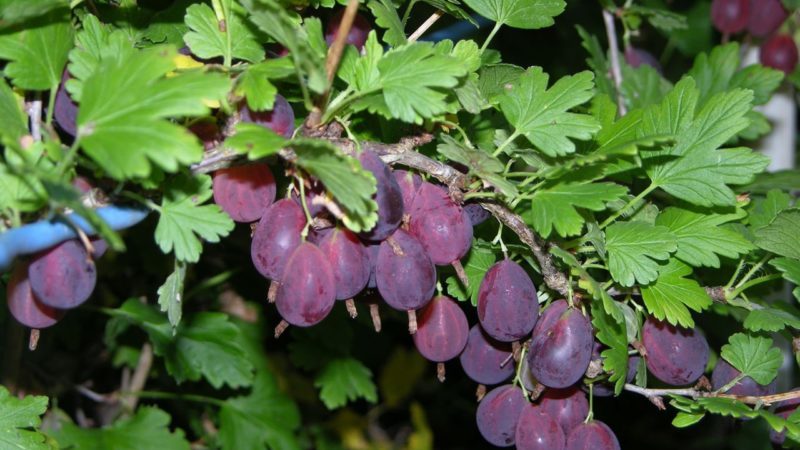
History of origin and distribution
The variety was bred at the All-Russian Institute of Selection and Technology of Horticulture and Nursery. IV Popova worked on the project, experimenting with crossing 3 varieties: Northern Captain, 595-33 and Moscow Red. The goal was to create a robust studless hybrid suitable for growing in different regions. The result was an unpretentious shrub with amazingly shaped fruits, without thorns, with a pleasant taste. And although the pear-shaped gooseberry is not included in the State Register of the Russian Federation, this does not prevent it from being popular with gardeners.
Characteristics and description of the bushes
Grushenka is a slightly spreading, compact and low plant. Branched shoots, without sharp thorns, the lower ones are lowered to the ground. The foliage is bright green with a glossy sheen. The bush is capable of producing many young shoots with fruit buds.
Resistant to temperatures
The Grushenka variety is resistant to high and low temperatures. It tolerates frost well down to -30 ° C. The flowering bush does not suffer from unexpected frosts, so this variety can be grown even in regions with cold climates.
Moisture and drought resistance
There are no exact data on the maximum temperature, but the variety grows well in southern Russia, where the thermometer often rises to + 40 ° C.
The gooseberry is not afraid of the heat and droughts, but excessive soil moisture can lead to the death of the plant - the roots will quickly rot and stop feeding the bush.
Disease and pest resistance
Experts note the high immunity of the variety to viral diseases. Grushenka is not afraid of powdery mildew, septoria and pests.
Reference. The variety practically does not need in chemical treatment (only in the most extreme cases), which allows you to get an environmentally friendly harvest.
Characteristics and description of fruits
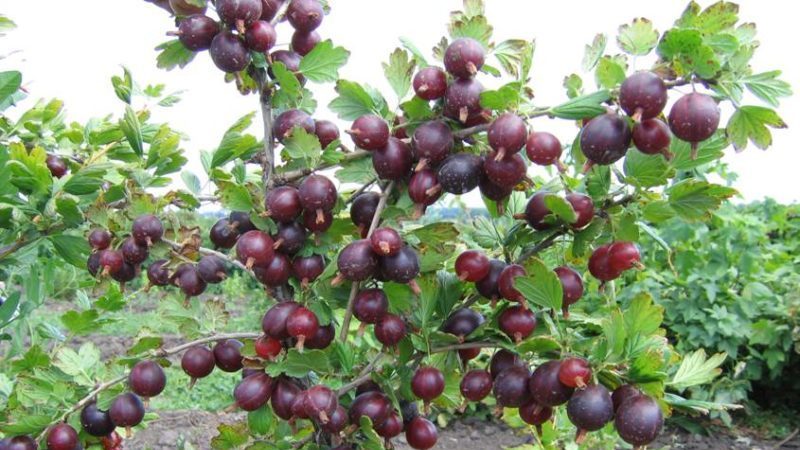
The variety got its name due to the unusual shape of the fruit - round, expanding downward. Over the entire ripening period, the color of the berries changes from yellow-green with a red bloom to purple. Average weight - 4-5 g. Berries densely cover the shoots of the bush, often hiding foliage. In a good year, up to 6 kg of harvest can be harvested from each bush.
Technical ripeness occurs in the second half of July, full ripening occurs at the end of August.
Application area
Thanks to their dense skin, Grushenka fruits are ideal for making jam, compote and confiture. The berries remain intact even after heat treatment. They tolerate freezing well and are suitable for fresh consumption.
Advantages and disadvantages of the variety
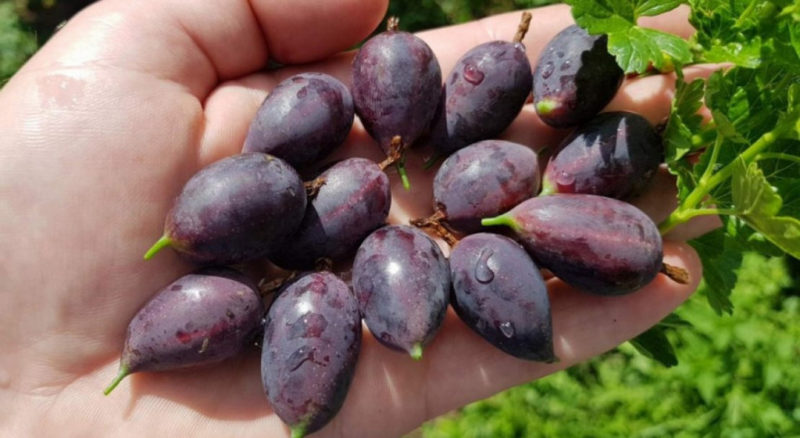
The Grushenka variety has several significant advantages:
- tolerates severe frosts;
- resistant to drought and heat;
- studless;
- has a strong immunity to diseases and pests;
- good yield indicators;
- not afraid of transportation;
- bears fruit from the age of three for 20 years.
But before buying Grushenka's seedlings, it is worth familiarizing yourself with the shortcomings that are inherent in this variety:
- garter bushes required;
- berries are small with a pronounced sourness in taste;
- does not like an abundance of moisture.
Growing technology
Even a novice gardener can grow such a gooseberry.
Optimal conditions
Suitable for growing Grushenka any soil composition, but the bush feels best in loam. The soil should be loose, with neutral acidity and good nutritional value.
For this variety, a permanent place is immediately chosen, because an adult plant is bad transfers a transplant... A well-lit area with light partial shade is required. It is important to protect the seedlings from drafts and wind, so the best place for them is along the fence.
Reference. Vegetable crops will become good predecessors for Grushenka. But currants impoverish the soil, and gooseberry seedlings after it do not take root or bear fruit poorly.
Terms and rules of landing
Experts recommend planting Grushenka in the fall, 1-1.5 months before the first frost. This period is enough for the bush to take root. In the spring, choose the interval between the thawing of the soil and the beginning of the growing season.
The seedling must be healthy, with well-developed roots and shoots, and no signs of disease or damage. Bushes with shoots 10-15 cm high are ideal.
It is important to plant correctly, in compliance with all conditions, in order to provide the plant with quick adaptation and stable growth:
- Soak the roots of the seedling in a growth promoter.
- Prepare holes for each bush. You will need 50 cm depth and a diameter the size of the root system.
- Pour a bucket of humus mixed with mineral fertilizers into the pit and sprinkle with a small layer of earth.
- Embed the seedling at an angle. Lower the root collar 5-6 cm underground.
- Moisten and compact the soil abundantly.
Further care
The variety bears fruit even without the participation of a gardener, but with a loss in the quality and quantity of berries. If you follow simple rules of care, you can achieve a rich and stable harvest. To do this, carry out regular watering, pruning, feeding and tying shoots:
- Support. Tie up the base of the bush and lateral shoots follow, which may suffer from an abundance of berries or strong winds.
- Top dressing... Fertilizers are often applied depending on the condition of the soil and the health of the bushes. 1-2 times a year, a complex mineral fertilizer is applied to the soil, and in the fall - superphosphate. The first feeding is carried out a year after planting, there is enough humus for the whole season.
- Pruning. In the spring, sanitary pruning is carried out, removing too long, dry and diseased shoots. In summer and early autumn, branches are pruned, thickening the crown.
- Watering. If there is enough rainfall, the bushes do not need watering. In arid climates, Grushenka is watered 4 times a season: during flowering, during the formation of ovaries, during the ripening of berries and when leaving for the winter. An adult bush needs 2 buckets of water. Young seedlings that are placed in the soil in the spring need weekly watering.
Possible problems, diseases, pests
Gardeners note that this variety is practically not susceptible to disease. But there are several types of insects that can harm the bushes:
- Fruit aphids, due to which leaves curl, dry out and fall off. Get rid of it by spraying with soapy water.
- Spider mite. When damaged by this pest, the underside of the yellowed leaves is covered with cobwebs. In this case, the bushes are sprayed with wormwood infusion.
- Fireball. Damages the pulp of berries.Affected fruits are removed, the gooseberries are sprayed with Aktellik.
Wintering
Due to its resistance to frost, the variety does not need additional shelter for the winter. In autumn, several simple procedures are carried out that will help Grushenka to wait out the cold season:
- cut dry and diseased shoots;
- in order to combat pest larvae, treat the bushes with Bordeaux liquid;
- remove debris, mulch and fallen leaves.
Reproduction
Grushenka is propagated vegetatively - by cuttings and layering. To obtain a cutting from an adult bush, branches are cut from 15 to 20 cm long. The sections are treated with Kornevin. They do this in July - August. Cuttings are dropped into the nutrient soil, leaving 2-3 buds on the surface. Water the sprouts until new shoots begin to grow.
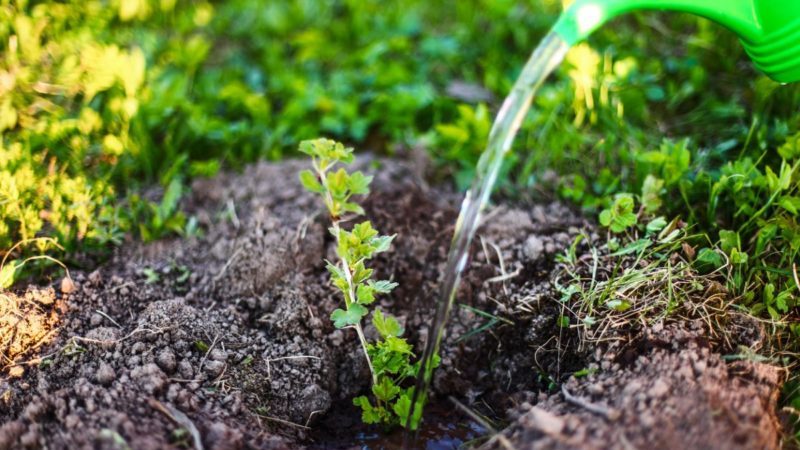
Gardeners most often use layering propagation. Annual shoots located in the lower part of the bush are bent to the ground and fastened in the middle with a bracket. This place is covered with earth and watered regularly. When rooting occurs, and new shoots begin to grow, the cuttings are cut off and planted in a permanent place.
Features of cultivation depending on the region
Gooseberry variety Grushenka is well suited for different regions. In areas with strong gusty winds in winter, it should be covered with burlap or other material.
Pollinating varieties
Self-fertile Grushenka does not need pollinating varieties.
Reviews of summer residents

Thanks to its positive qualities, the Grushenka variety is loved by summer residents. Even inexperienced gardeners are not afraid to grow it.
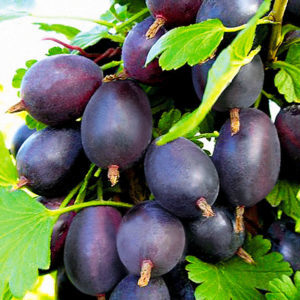
Nadezhda Osipova, Lipetsk: “Grushenka is very unpretentious and does not require special attention. I regularly treat aphids with a garlic solution (300 g of chopped garlic per 1 liter of water) and tie up the branches. The rest of the bush grows on its own. The harvest is stored in the cellar for 2-3 months, if the fruits are harvested before full ripening. "
Ilya Korneev, Tula: "The first planting died due to the close location of groundwater (roots rotted), it was necessary to pick up another site. In the new place, the gooseberry quickly took root, the harvest was harvested in the second year after planting. The fruits are used for jam, there are many of them. The bushes do not get sick, I do not cover for the winter. Once every 2 months I add fertilizers and thin out the crown. "
Conclusion
Grushenka is an ideal variety for beginner gardeners. It is unpretentious in care, is not afraid of frost, drought and disease, gives a rich harvest and multiplies easily. The fruits can be used both for conservation and for freezing. Thanks to the dense skin, the berries are stored for a long time and are not afraid of transportation.